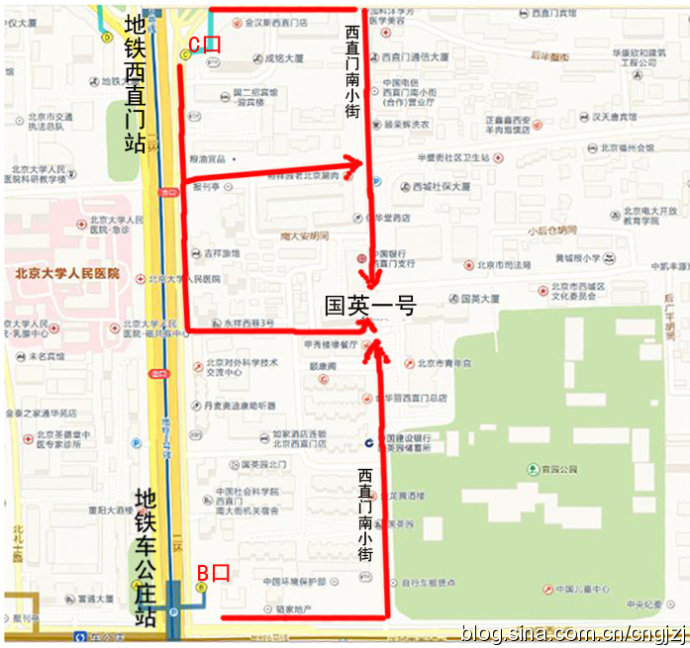中国民间中医医药研究开发协会国际针灸合作委员会
办公地点现在已经搬迁至西城区西直门南小街国英园一号楼824室,
同时为方便大家联系,固定电话已经变更
新号码010—58562339。特此通知。
地址:北京西城区西直门南小街国英园一号楼824室
邮编:100035
电话:010-58562339
传真:010-58562339
邮箱:cngjzj@163.com
网站(点击网址直接链接↓):http://www.cngjzj.com/
博客(点击网址直接链接↓):http://blog.sina.com.cn/cngjzj
交通路线图 (点击观看大图)

从首都机场乘坐机场专线,在东直门站下车换乘地铁2号线开往西直门方向,在西直门站 C 口出站:
1、沿西直门内大街向东直行100米,右拐到西直门南小街,向南步行到丁字路口即到国英园1号楼楼下。
2、向南直行50米,绕过 国二招宾馆 沿着中大安胡同向东到西直门南小街,向南步行到丁字路口即到国英园1号楼楼下。
从首都机场内乘坐机场直达西单的大巴,在西单站下车,乘坐出租车到西直门南小街国英园1号楼。
公交官园站:107路,运通106路
公交西直门南:387路,44路,800内环,816路,820内环,845路
地铁车公庄:地铁二号线
地铁西直门:地铁二号线
公交车公庄东:107路,118路,701路
公交车公庄北:209路,375路,392路
 您现在的位置是:
首页 >>
Technology promotion技术推广 >>
Technology promotion技术推广
您现在的位置是:
首页 >>
Technology promotion技术推广 >>
Technology promotion技术推广
2012年02月22日
 复制链接
复制链接
 打印
打印
 大 中 小
大 中 小
The back of the human body seven inspection technology
Back color, spot changes
Text / Ma Lichang
Back color, spot changes heralded by some as early manifestation of the disease. The back of the pigment spots are often associated with their health are closely related, these spots or a symptom of certain diseases. Through to the back of each part of the color and changes to determine the health status of a method. Back at the color diagnosis in TCM Yin Yang and five elements theory is a foundation, managed with Five-color Theory is specific apply. Although the back color due to genetic, occupation, gender, age, ethnic differences, as well as the climate, seasonal changes, will vary, but there are still some generality. In order to run for the color, color, luster bright run is regular. In normal Chinese people back is yellowish-white, Ming Run sheen. As Ming Run implicitly, although it did not hurt viscera disease, prognostic and good; if dark, exposure, it hurt viscera diseases severity, prognosis, and more fierce. The human body due to labor, drinking, or causes extreme impact, there are some color changes, the general should not be regarded as a disease of color.
Five main disease has two kinds of meanings, first representing the different organs of the disease. " Lingshu." "put forward by colored colors of life organs for liver, green, red for the heart, white for the lung, spleen kidney yellow, black". Followed by the colors represent different nature of the disease," black Huang Chiwei for pain, heat, white for" cold".
White
White 's virtual, main cold, the main blood loss, inflammation, pain and anemia in. White out of honor you, where Yang Asthenia of Qi and blood running, weakness, or loss of blood deficiency causing gas consumption looks, the corresponding viscera back area is white. As of the kidney area showed a white, is the deficiency of kidney qi; spleen and stomach area has the white one is white and the spleen and stomach; but who is Yang deficiency; pale and thin for blood deficiency camp; red and white for more inflammation; the entire back ( including nail white is a symbol of anemia and blood loss.
Yellow
The main deficiency, wet, yellow main main long illness. Yellow is the spleen deficiency wefness the phenomenon, often prompting hepatobiliary disease, or chronic disease. The organs of chronic diseases in general in the back area will appear yellow spots, or a cocoon-like nodules. Hepatobiliary diseases caused by obstructive jaundice, face, eye, body are yellow, on the back are generally yellow. Yellow and bright, such as orange, Yang Huang, more humid; yellow and dull as smoked, Yin Yellow, is cold. Long strong area yellow note pharyngitis longer course of disease, the stomach area yellow and rough description of stomach long course, if the skin is more convex, prompt gastric mucosal thickening.
Red
Red as blood, main fever. Hot fill and choroidal filling, a red. Back inspection should pay attention to the following different red:
Light red -- description of organ function, can be seen in the early stages of disease, or chronic illness will heal and low fever.
Deep red -- usually indicates the presence of heavy inflammation, tracheal corresponding area was dark red dot is inflammation of the airways, lung heat. In the long strong area such as red Folder white a bit flaky, prompts the pharynx has purulent lesions.
Bright red cinnabar mole -- except for the back, usually to the point of form, often prompts a corresponding organ hemorrhage, or bleeding.
Dark red -- prompted a longer course of disease, or that is in the past illness or physical wounds had healed.
Red brown -- that disease will heal or rehabilitation soon, or operation wound has healed.
Purple -- suggests that blood stasis, circulation is not good, or bleeding after initiation of coagulation.
Cyan
Cyan main cold, pain, ecchymosis, main main main fan. Green for the stagnation of blood stasis in complexion, meridians, qi stagnation and blood stasis or pain, but on the back of the corresponding parts of cyan, or even purple. Back of stomach and duodenum in the pale of spleen deficiency. Purple indicates blood stasis in the more serious, such as the insufficient blood supply to the brain, which side of the brain blood supply insufficiency, relative cerebral vascular area will appear purple. Back everywhere purple ecchymosis, said dyslipidemia, also expressed in blood of high acidity, amount of oxygen in the blood is reduced, blood is easy to coagulate, easy occurrence of cerebral thrombosis. Cardiac conduction system adverse, back is dark purple, suggestive of high blood lipids, in vivo metabolites from impeded, stasis in vivo, therefore often feel tired. Green said the blood viscosity, high acidity or color elasticity of vascular wall weakened, even hardened.
Black
Black 's kidney, blood stasis. Black as deficiency decline, cold water disease color. Black spots on the back of the hand in senile plaques, in the back on the corresponding surfaces appear, prompting the corresponding organs have more long-term chronic disease or severe.
Spot color characteristic: white, yellow, brown, gray, blue, black, and black and red colors, in the same patient most appear only a few points of color reaction, two colors, very few appear three or four colors. No matter which kind of color reaction, its color is the same as the surrounding skin is significantly different, very easy to distinguish, but of different sizes.